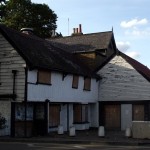What’s so important about an old pub?
“The existence of several of West Ham’s inns can be traced from the 16th century or earlier. The Cock at Stratford occurs in 1485. The Blue Boar, High Street, Stratford, mentioned in 1538, was rebuilt in 1886, refronted c. 1936, and later demolished. The Angel, Church Street, was formerly a timberframed building of the 16th or early 17th century but was rebuilt in 1910. The Spotted Dog, Upton Lane, is the only ancient building, apart from the parish church, which survives in West Ham. It is a timber-framed structure dating from the 16th century or earlier, but has been much restored. It consists of a central block, which may once have contained an open hall, flanked by two-storeyed and jettied cross-wings with weatherboarded gables. A large extension of yellow brick was built to the north in the later 19th century. In 1968 the inn was thoroughly renovated and a smaller addition, partly weatherboarded, was built to the east. In the later 19th century the Spotted Dog’s tea-garden and cricket ground were well-known.
Among other early inns was the Swan, Stratford, first recorded in 1631. Early in the present century the Swan, next to the town hall in High Street, was an 18th-century building of three storeys and attics, with a 19th-century frontage to the ground floor. It was rebuilt c. 1925. The Bird in Hand, in the same street, existed in 1667 and survived until c. 1892. The Unicorn, Church Street, is recorded from c. 1670 to 1908.”
Victoria County History of Essex Vol 6
Thanks to John Plant for his research.
